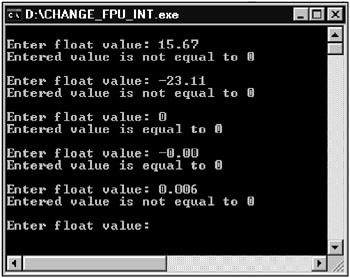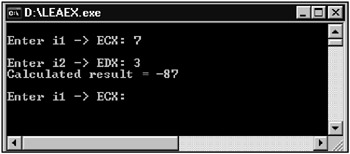Main Methods of Optimizing Mathematical Calculations
Main Methods of Optimizing Mathematical Calculations
In the C++ .NET programming environment, as well as in other high-level languages, you can use assembly language to develop efficient solutions for optimizing crucial fragments of a program. The results may be varied in terms of performance and program code size . Below, we will consider several examples that are used successfully in practice. They use assembly language to improve the quality of the program code. We will examine how mathematical operations can be optimized. There are several methods for doing so.
Method 1. Using Integer Instructions
Instead of the FPU commands, you can use integer instructions. The data transfer operations can be replaced by more efficient integer commands. For example, commands such as
fld QWORD PTR [ESI] fstp QWORD PTR [EDI]
can be replaced by these:
mov EAX, [ESI] mov EBX, [ESI+4] mov [EDI], EAX mov [EDI+4], EBX
Method 2. Optimizing Zero Test for Floating-point Numbers
To check if a floating-point number is equal to zero (0), you can use the integer instructions as well. Note the code that implements the zero test by using a sequence of the FPU commands. Here is the source code of a simple C++ .NET console application using this test (Listing 2.10).
| |
// CHANGE_FPU_INT.cpp : Defines the entry point for the console // application #include "stdafx.h" int _tmain(int argc, _TCHAR* argv[]) { float f1 = 0; float *pf1 = &f1; bool isZero; while (true) { printf("\nEnter float value: "); scanf("%f", pf1); _asm { mov ECX, 1 mov EBX, DWORD PTR pf1 finit fld DWORD PTR [EBX] ftst fstsw AX sahf jz ex mov ECX, 0 ex: mov DWORD PTR is Zero, ECX fwait } if (isZero) printf("Entered value is equal to 0\n"); else printf("Entered value is not equal to 0\n"); } return 0; } | |
An equivalent variant of the program using the ordinary assembly commands may look like this (here, only the assembly code fragment is shown):
. . . _asm { mov ECX, 1 mov EBX, DWORD PTR pf1 mov EAX, DWORD PTR [EBX] add EAX, EAX jz ex mov ECX, 0 ex: mov DWORD PTR isZero, ECX } . . . For further optimization to the zero test algorithm, try to eliminate the branching of the program code. To do this, find an equivalent for the jz ex conditional jump command. For example, you can use the cmov command with the corresponding condition. With these changes, the assembly code fragment will look like this:
. . . _asm { mov ECX, 1 mov EBX, DWORD PTR pf1 mov EAX, DWORD PTR [EBX] add EAX, EAX cmovz EAX, ECX mov ECX, 0 cmovnz EAX, ECX mov DWORD PTR isZero, EAX } . . . Take into account that the latter two code fragments work with the operands in double-word format. For float numbers with double precision (QWORD), you need to test only the bits numbered 32 ˆ’ 64. If these bits are equal to 0, then the number is equal to 0.
Fig. 2.7 shows the application window for all three modifications of the program code.

Fig. 2.7: Application that tests whether the given floating-point number is equal to zero (0)
Method 3. Using the LEA Commands for Optimization
To optimize mathematical calculations, you can also use the lea commands to load the address. For example, a command such as
lea EAX, 3[-100][EDX+ECX]
can replace a whole group of the following commands:
mov EAX, ECX add EAX, EDX add EAX, 100 sub EAX, 3
In Listing 2. 11, note the source code of a small console application using this command.
| |
// LEAEX.cpp : Defines the entry point for the console application #include "stdafx.h" int _tmain(int argc, _TCHAR* argv[]) { int i1, i2, ires; while (true) { printf("\nEnter i1 > ECX: "); scanf("%d", &i1); printf("\nEnter i2> EDX: "); scanf("%d", &i2); _asm { mov EDX, DWORD PTR i1 mov ECX, DWORD PTR i2 lea EAX, 3 [ 100] [EDX+ECX] mov DWORD PTR ires, EAX } printf("Calculated result = %d\n", ires); } return 0; } | |
The source code of the program is simple and does not require further explanation. Fig. 2.8 shows the window with this application running.

Fig. 2.8: Using the LEA (address loading) command for performing mathematical operations
We have considered only a part of the whole set of assembly mathematical functions. This consideration encourages you to use the full range of FPU features in your programs in assembly language. If necessary, you can use assembly language to modify existing mathematical algorithms, or even write your own, which are not found in high-level languages.
EAN: 2147483647
Pages: 50